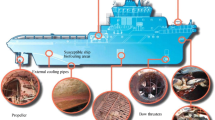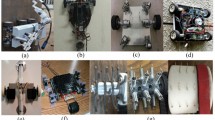Abstract
This paper proposes a novel swimming robot with waterbomb origami wheel. The wheel of the swimming robot is a waterbomb origami that acts like a paddle blade. The origami wheel provides a new propulsion way for the swimming vehicle. The propulsion principle is to use the water flow to push the origami structure like the blade to propel it move forward. The analytical model describing the mechanical behavior of the origami wheel was built to illustrate the superior swimming characteristics of the robot. The model uncovers propulsive force variation with respect to origami structure parameters. The prototypes of the swimming robot are manufactured to analyze the influence of the structural parameters on their performances such as swimming speed, steering, and propulsive force. The analysis results showed that the proposed swimming robot has advantages such as high propulsion force and fast response. Meanwhile, it provides a guideline for the structural design of the origami wheel that enables it to be suitable to swim in the water. In a word, the origami wheel provides a light and efficient propulsion for swimming vehicles. The origami wheel provides a novel and simple propulsion way for swimming vehicles, and the structure promotes the development of a new class of swimming vehicles.
Similar content being viewed by others
References
L. Li, G. Li, R. Li, Q. Xiao and H. Liu, Multi-fin kinematics and hydrodynamics in pufferfish steady swimming, Ocean Engineering, 158 (2018) 111–122.
J. Y. Shao and T. Q. Li, Fish-like swimming in oblique flows: A numerical investigation, Ocean Engineering, 230 (2021) 109005.
G. Su, H. Shen, N. Li, Y. Zhu and Y. Su, Numerical investigation of the hydrodynamics of stingray swimming under self-propulsion, Journal of Fluids and Structures, 106 (2021) 103383.
S. Bahri, R. P. A. Setiawan, W. Hermawan and M. Z. Junior, Design and Simulation of paddle wheel aerator with movable blades, International Journal of Engineering Research and Technology, 4(2) (2015) 994–999.
J. Hu, H. Li and W. Chen, A squid-inspired swimming robot using folding of origami, The Journal of Engineering, 2021(10) (2021) 630–639.
J. P. Panda and A. Mitra, A review on the hydrodynamic characteristics of autonomous underwater vehicles, Proceedings of the Institution of Mechanical Engineers, 235(1) (2021) 15–29.
A. Rafsanjani, Y. Zhang, B. Liu, S. M. Rubinstein and K. Bertoldi, Kirigami skins make a simple soft actuator crawl, Science Robotics, 3(15) (2018) 457–469.
Y. Zhao, Y. Endo, Y. Kanamori and J. Mitani, Approximation 3D surfaces using generalized waterbomb tessellations, Journal of Computational Design and Engineering, 5 (2018) 442–448.
L. M. Fonseca, G. V. Rodrigues, M. A. Savi and A. Paiva, Nonlinear dynamics of an origami wheel with shape memory alloy actuators, Chaos, Solitons and Fractals, 122 (2019) 245–261.
J. Ma, H. Feng, Y. Chen, D. Hou and Y. Zhong, Folding of tubular waterbomb, Research, 2020 (2020) 1735081.
Y. Zhao, Y. Kanamori and J. Mitani, Design and motion analysis of axisymmetric 3D origami with generic six-crease bases, Computer Aided Geometric Design, 59 (2018) 86–97.
J. Mitani, Column-shaped origami design based on mirror reflections, Journal for Geometry and Graphics, 16(2) (2012) 185–194.
S. Felton, M. Tolley, E. Demaine, D. Rus and R. Wood, A method for building self-folding machines, Science, 345 (2014) 644–647.
C. D. Onal, R. J. Wood and D. Rus, An origami-inspired approach to worm robots, IEEE/ASME Transactions on Mechatronics, 18(2) (2013) 430–438.
T. Liu, Y. Wang and K. Lee, Three-dimensional printable origami twisted tower: design, fabrication, and robot embodiment, IEEE Robotics and Automation Letters, 3(1) (2018) 116–123.
P. Bhovad, J. Kaufmann and S. Li, Peristaltic locomotion without digital controllers: exploiting multi-stability in origami to coordinate robotic motion, Extreme Mechanics Letters, 32 (2019) 100552.
T. Chen, O. R. Bilal, K. Shea and C. Daraio, Harnessing bistability for directional propulsion of soft, untethered robots, Proc. Natl. Acad. Sci., 115 (2018) 5698–5702.
T. Mukhopadhyay, J. Ma, H. Feng, D. Hou, J. M. Gattas, Y. Chen and Y. Zhong, Programmable stiffness and shape modulation in origami materials: Emergence of a distant actuation feature, Applied Materials Today, 19 (2020) 100537.
D. Y. Lee, S. R. Kim, J. S. Kim, J. J. Park and K. J. Cho, Origami wheel transformer: A variable-diameter wheel drive robot using an origami structure, Soft Robotics, 4(2) (2017) 163–180.
P. H. Le, J. Molina and S. Hirai, Application of Japanese origami ball for floating multirotor aerial robot, World Academy of Science, 8 (2014) 1740–1743.
L. M. Fonseca and M. A. Savi, Nonlinear dynamics of an autonomous robot with deformable origami wheels, International Journal of Non-Linear Mechanics, 125 (2020) 103533.
X. L. Xie, F. Gao, C. Huang and W. Zeng, Design and development of a new transformable wheel used in amphibious allterrain vehicles (A-ATV), Journal of Terramechanics, 69 (2017) 45–61.
M. Sfakiotakis, D. M. Lane and J. B. C. Davies, Review of fish swimming modes for aquatic locomotion, IEEE Journal of Oceanic Engineering, 24(2) (1999) 237–252.
Acknowledgments
This work is supported by the National Natural Science Foundation of China (52165011, 51865016), Jiangxi Natural Science Foundation of Jiangxi Province - Key Project (2020 ACBL204009), Jiangxi Natural Science Foundation of Jiangxi Province (20212BAB204028), Science and the Program of Qingjiang Excellent Young Talents, Jiangxi University of Science and Technology (JXUSTQJBJ2018006).
Author information
Authors and Affiliations
Corresponding author
Additional information
Junfeng Hu is a Professor at the School of Mechanical & Electrical Engineering, Jiangxi University of Science and Technology, Ganzhou, China. He received his Ph.D. in Mechanical Engineering from South Chin-a University of Technology. His research interests include Origami robot, compliant mechanism and soft robot.
Ning Zhang is currently a M.E. candidate at the School of Mechanical & Electrical Engineering, Jiangxi University of Science and Technology, China. His research interests include origami robots.
Rights and permissions
About this article
Cite this article
Hu, J., Zhang, N. Design and performance analysis of a novel swimming robot with waterbomb origami wheel. J Mech Sci Technol 37, 4837–4846 (2023). https://doi.org/10.1007/s12206-023-0836-4
Received:
Revised:
Accepted:
Published:
Issue Date:
DOI: https://doi.org/10.1007/s12206-023-0836-4




